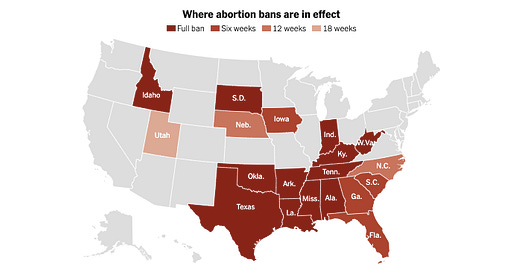Americans are leaving anti-abortion states. I suspect these are some of the reasons:
Americans overwhelmingly are pro-choice and not only resent public officials in these states taking away their rights but don’t want to suffer these health consequences:
Inability to have surgical or chemical abortions, for any reason, including rape, incest, threats to the life of the mother, stillbirth, miscarriage or imminent fetal death. Even if the laws technically allow abortions under these circumstances, physicians and other healthcare providers may not want to risk a felony prosecution and loss of their license due to an overzealous prosecutor seeking publicity.
Difficulty in obtaining medical care as OB-GYNs and other physicians leave or decide not to practice in these states because they cannot practice medicine as they deem proper or they feel threatened by State legislation.
Threats to other medical care for women and girls, even if not pregnant, that might harm an embryo or fetus if they become pregnant. This includes the treatment of cancer, autoimmune and other diseases.
Threats of criminal prosecution for having a miscarriage, as has occurred in many of these states.
Repulsion towards the people of a state who elect officials who want to provide severe prison sentences or even the death penalty for women or girls who have abortions or those who help them get abortions elsewhere.
I support these pro-choice blogs and organizations and suggest you do too:
Blogs: Abortion Every Day, News From The States,
Organizations: ACLU, Planned Parenthood
What do the data show about anti-abortion state migration?
National Bureau of Economic Research (January 2025):
In this study, we investigate whether reproductive rights affect migration. We do so using a synthetic difference-in-differences design that leverages variation from the 2022 Dobbs decision, which allowed states to ban abortion, and population flows based on change-of-address data from the United States Postal Service. The results indicate that abortion bans cause significant increases in net migration outflows, with effect sizes growing throughout the year after the decision. The most recent data point indicates that total abortion bans come at the cost of more than 36,000 residents per quarter. The effects are more prominent for single-person households than for family households, which may reflect larger effects on younger adults. We also find suggestive evidence of impacts for states that were hostile towards abortion in ways other than having total bans.
CNBC/Generation Lab. Their poll (May 2024) found that:
62% of young people wouldn’t live in a state with an abortion ban. Thirty-two percent of adults ages 18-34 said they would “probably not” live in a state with an abortion ban, while another 30% said they would “definitely not” live in an anti-choice state. Forty-five percent of young people also said that they would “definitely” or “probably” reject a job offer in a state with an abortion ban.
An October 2024 Redfin Survey reported that nearly 1 in 10 Gen Zers who plan to move cite abortion rights as a reason:
Seven percent of Gen Zers who plan to move soon say one reason is to live in a place where abortion is legal and accessible, and one in 20 (5%) millennials say the same thing, according to a new report from Redfin (redfin.com), the technology-powered real estate brokerage.
At least 50% of respondents across every generation said they want to live somewhere abortion is legal, with millennials leading the way; 59% said they want to live in such a place, followed by just over half of both Gen Zers and Gen Xers, and exactly half of baby boomers (note that the oldest baby boomers surveyed were 65). Baby boomers and Gen Xers were mostly likely to say they don’t want to live somewhere abortion is legal (30% each).
Overall, 54% of respondents want to live in a place where abortion is legal, compared to 28% who don’t want to.
In May 2024, the Association of American Medical Colleges reported that residency applications dropped by double digits in states with bans:
A 2023 analysis by the AAMC Research and Action Institute found that fewer new graduates of U.S. medical schools applied to residency programs in states that banned or restricted access to abortion than to residency programs in states where abortion remained legal. That analysis was performed after the U.S. Supreme Court issued its decision on Dobbs v. Jackson Women’s Health Organization in June 2022
I suspect that the trend of young people and physicians leaving anti-abortion states will accelerate until these States reverse their policies, although that likely will take a long time.
The index to my prior essays (mostly post 5 November 2024) is here.
I have another blog on Cancer and Medicine.
You can also follow me at https://www.linkedin.com/in/nat-pernick-8967765/ (LinkedIn), npernickmich (Threads and Instagram), natpernick.bsky.social (Bluesky) or @nat385440b (Tribel).
Email me at Nat@PathologyOutlines.com.
I also publish Notes at https://substack.com/note. Subscribers will automatically see my notes.




